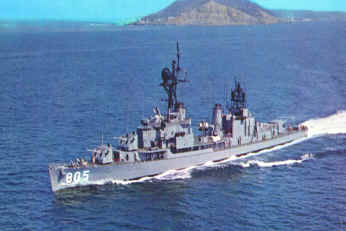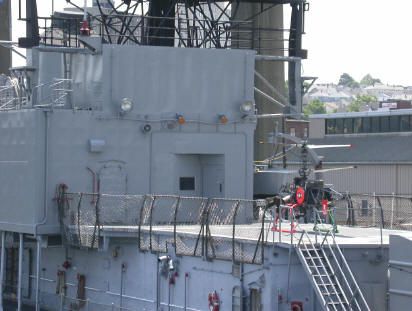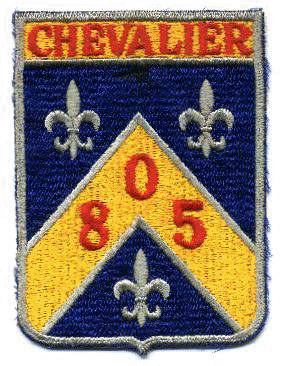ASLEEP ON WATCH
By Richard H. King, CDR USNR-Ret.
U.S.S. CHEVALIER (DD-805)
The USS CHEVALIER (DD-805): I was on that ship well
over three years and went through two captains, three chief engineers, three
XO's and by the time I left, I knew every nut, bolt and screw holding it
together. I came aboard as an ensign fresh from college graduation and a
midshipman cruise and left as a LT (O-3) but I didn't know I was a LT (O-3)
until I arrived at Treasure Island for separation. The following story is from
the time I was an ensign.
 Asleep on Watch: It was a criminal offense and in wartime
could draw a very severe penalty. But the way the Navy did things in the sixties
left me scratching my head. Once the ship went first from five, then to four and
then to three duty sections during ops in Vietnam, fatigue and sleep deprivation
started showing its ugly head. One of the "sleepiest" "O" watches was CICWO (CIC
Watch Officer). Four hours in a warm dark room with absolutely nothing
happening. A big comfortable chair. When the "CICPOW" (CIC Petty Officer of the
Watch) found the CICWO (CIC Watch Officer) asleep what should he do? This was an
enigma. Wake him up or write him up? Then there was the "after steering watch".
Do absolutely nothing in a sleep deprived state between 0400 and 0800 or
whatever. We used to run a drill on this watch, transfer steering to him for
about twenty minutes to keep him awake.
Asleep on Watch: It was a criminal offense and in wartime
could draw a very severe penalty. But the way the Navy did things in the sixties
left me scratching my head. Once the ship went first from five, then to four and
then to three duty sections during ops in Vietnam, fatigue and sleep deprivation
started showing its ugly head. One of the "sleepiest" "O" watches was CICWO (CIC
Watch Officer). Four hours in a warm dark room with absolutely nothing
happening. A big comfortable chair. When the "CICPOW" (CIC Petty Officer of the
Watch) found the CICWO (CIC Watch Officer) asleep what should he do? This was an
enigma. Wake him up or write him up? Then there was the "after steering watch".
Do absolutely nothing in a sleep deprived state between 0400 and 0800 or
whatever. We used to run a drill on this watch, transfer steering to him for
about twenty minutes to keep him awake.
The absolute worst was the "after lookout".
He had to climb the ladder to the top of the
 ship's
DASH (Drone Anti-Submarine Helicopter) hanger (seen at
left) and position himself behind the ECM shack looking aft into our
wake. He was on the JA circuit I believe. For four hours he was supposed to
"remain awake and alert" looking for (1) sailors who have jumped over the side
(or in one case in the Med cruise, a Commodore) or (2) fast moving enemy ships
closing us from astern. Needless to say, over the years, an after lookout fell
asleep on watch more than once. This "falling asleep on watch" deal was not
uniformly enforced and was used in a manner not intended. The problem was during
Vietnam, the draft, and every destroyer received some terrible sailors. Most
were outstanding but not 100%. There were some really bad ones that no one knew
what to do with. I listened in advance to a scheme where junior Weapons
Department Officers decided to assign a sailor they really didn't like (hated)
and wanted to "get rid of" to "after lookout". Then they had an E-4 Boatswain
Mate sneak back there every 45 minutes or so to "catch him asleep". He was
finally "caught" and I was assigned to sit on the Court Martial. (Sleeping on
Watch during Wartime). It was a "Summary? - three officers". ship's
DASH (Drone Anti-Submarine Helicopter) hanger (seen at
left) and position himself behind the ECM shack looking aft into our
wake. He was on the JA circuit I believe. For four hours he was supposed to
"remain awake and alert" looking for (1) sailors who have jumped over the side
(or in one case in the Med cruise, a Commodore) or (2) fast moving enemy ships
closing us from astern. Needless to say, over the years, an after lookout fell
asleep on watch more than once. This "falling asleep on watch" deal was not
uniformly enforced and was used in a manner not intended. The problem was during
Vietnam, the draft, and every destroyer received some terrible sailors. Most
were outstanding but not 100%. There were some really bad ones that no one knew
what to do with. I listened in advance to a scheme where junior Weapons
Department Officers decided to assign a sailor they really didn't like (hated)
and wanted to "get rid of" to "after lookout". Then they had an E-4 Boatswain
Mate sneak back there every 45 minutes or so to "catch him asleep". He was
finally "caught" and I was assigned to sit on the Court Martial. (Sleeping on
Watch during Wartime). It was a "Summary? - three officers".
I went to the XO and told him I was privy to wardroom
conversations that should disqualify me from the court martial. He refused to
take me off the court. So I sat and listened to the testimony. The Court voted
two to convict and one for acquittal. Boy did the XO give me hell. He was
foaming at the mouth about my "vote". He was an LCDR and I was just an ensign
(0-1) but I told him the story and told him if he didn't like my vote, never
assign me to a Court Martial again. That's when I decided to go to law school.
 I
don't like telling this story, because it makes my
ship look bad. It also makes Chevalier's junior weapons department officers
look bad and they were my friends. The "scheme" to get rid of this admittedly
zero sailor may not have been their idea but they endorsed it and set the scene
for it to work. Two Executive Officers later (XO's had very short tours) I was
again appointed to a court martial and I again requested to be excused because
the defendant had been in "OE" division while I was still the OE Division
Officer (before moving to engineering). The XO said being the defendant's
former division officer was not a good enough reason
to be excused. So I told him the story about my first Court Martial
service. I think he interpreted it to be a threat that if I was forced to serve
against my will, I would acquit ("if the Court doesn't fit you must acquit") (I
may have hinted that that would be the result) I was so "short" as they say on
the mess deck I could get away with that - I already had orders to report to
Treasure Island for separation! I
don't like telling this story, because it makes my
ship look bad. It also makes Chevalier's junior weapons department officers
look bad and they were my friends. The "scheme" to get rid of this admittedly
zero sailor may not have been their idea but they endorsed it and set the scene
for it to work. Two Executive Officers later (XO's had very short tours) I was
again appointed to a court martial and I again requested to be excused because
the defendant had been in "OE" division while I was still the OE Division
Officer (before moving to engineering). The XO said being the defendant's
former division officer was not a good enough reason
to be excused. So I told him the story about my first Court Martial
service. I think he interpreted it to be a threat that if I was forced to serve
against my will, I would acquit ("if the Court doesn't fit you must acquit") (I
may have hinted that that would be the result) I was so "short" as they say on
the mess deck I could get away with that - I already had orders to report to
Treasure Island for separation!
This was to be a one officer Court, I forget which is
which, Summary and Special. One is one officer and one is three officers. By
this time I had decided that the whole court martial system was rotten to the
core. The "rot" was what was even then called "command influence". If the
"command" wanted a conviction, the "court" (its members being under the same
command) were so directed in no uncertain words and that usually resulted in a
conviction. It became my opinion that every court martial should be conducted
ashore before a court zero percent of which (members) were under the
same command as the defendant. I think the Navy later did that
in the seventies or eighties.

Side Note: At the time of the first Court Martial, I was still EMO (Electronics
Material Officer) (OE Division Officer) in the Operations Department and the
defendant was in 1st Division (Deck Division) in the Weapons Department. By the
time I was appointed to the second Court, I was MPA (Main Propulsion Assistant)
(Assistant Engineering Officer for Main Propulsion) in the Engineering
Department and the defendant was an ET (Electronics Technician) in my former
division. Serving in two different departments during a slightly more than three
year tour was good; by the time I left I knew a hell of a lot about the ship. In
those days promotion from ensign (O-1) to LTJG (O-2) was almost automatic at 18
months. If you were not promoted at 18 months you must have really screwed up
bad. Promotion from LTJG (O-2) to LT (O-3) was not quite as automatic but
happened usually at 36 months from the commissioning date. By staying longer on
board than I was supposed to caused the interesting and unusual situation where
I was promoted from O-2 to O-3 while still on board (and I didn't even know it).

Well Cmdr King, you weren't the only crewman to fall Asleep on Watch......below
some of your fellow shipmates make their confessions:
From Terry Miller, STG3 (Sonar Technician
Third Class) of the
USS GEORGE K. MAC KENZIE (DD-836)
I stood after lookout on a rotating basis
as a bridge watch stander. (After steering was also on that rotation.) We
normally sat with dangling legs and leaned on the railing but I was feeling
particularly sleepy one mid-watch and decided if I didn't stand up I'd go to
sleep. The XO showed up not five minutes
later to check on me. They would transfer
steering to after steering usually once a night for about five minutes.
They did it once without the OOD's knowledge
while the QM took the wheel off the helm and sat down at the chart table and
polished it. Neither the OOD nor the JOOD
noticed.
Another time before they started rotating the duties the helmsman would stand
all four hours on the helm. One overcast midwatch a crazy seaman (later a BM-3)
steered the ship in a circle
for most of the four hours because his OOD and JOOD weren't paying attention.
The QM couldn't understand why the track was more than three hours behind his
calculations and he caught hell from the QMC.

From Len Barrett, RDSN (Radarman Seaman) of
the
USS JOSEPH P. KENNEDY JR. (DD-850)
I hate to admit it but on one
occasion, I fell asleep on watch. We were in Port and Starboard duty sections
any time we were underway. I had been aboard ship for about three months as a
RDSN (Radarman Seaman), reporting aboard right after RD "A" school. The worst
watch in CIC from the standpoint of staying alert on a midwatch was in the ECM
room.
The job was to set the ECM equipment on auto scan in the frequency band assigned
for search. The operator wore a headset to listen for any signals picked up by
the scanner. There was a scope, about three inches in diameter, which had a
visual presentation of any signals received as well as the audio through the
headset.
One night on midwatch, I was assigned the ECM watch. I thought that I was doing
a stand up job until my supervisor, an RD2 by the name of George Kornack, tapped
me on the shoulder. He asked why I was asleep. I denied it and he told me to
look closely at my glasses. I removed my glasses and looked. Petty Officer
Kornack had taken a grease pencil and scribbled all over both lenses of my
glasses while I was asleep.
Thankfully, no charges were pressed. However, I worked like I had not worked
before that time anytime he asked me to perform any task. I never fell asleep on
any watch after that.

 

|
